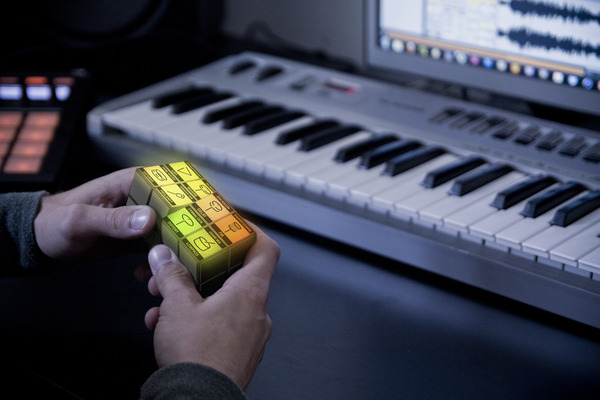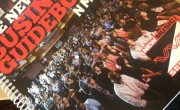By Keith Nelson Jr
MusixCube
In a move as simple as “taking the music producer away from the computer and allowing them to take back the music into their own hands” Hauke Scholz turned the Rubix Cube into a controller for recording software and MIDI players. MusixCube allows users to toggle through “layers” (Sampler, Options, Group, Levels, and FX) with a flip, twist to control effects, and even the glide of a finger on the cube’s surface to adjust mix and volume. The MusixCube is fully compatible with a bevvy of popular DAW software, including Reason, Logic, Pro Tools and Abelton Live. With the addition of Bluetooth-enabled collaborative editing via multiple MusixCube in close proximity of each other, Scholz’s thesis project can evolve into a major player in the mobile music recording industry.
Read our write-up of MusixCube
MOTU Microbook II
A shining beacon in the 2012 Do-It-Yourself music recording movement was MOTU’s Microbook II, a USB 2.0-powered portable audio interface designed for personal recording. The developer of computer-based audio/video production hardware and software equip the Microbook II with an XLR cable input, line input and two stereo inputs allowing for four-track simultaneous recording. Its one pound metal chassis gives it a mixture of durability and portability, essential for mobile recording setups. With on-screen Microbook II controller software, CueMix FX(Windows/Mac OS X) and MOTU’s own DAW software, AudioDesk (Mac) included, musicians can take the heart of a recording session anywhere they travel.
Read our write-up of the MOTU Microbook II
Audiobus
This year, 87% of the population had a mobile phone (roughly 5.9 billion) with 48% of those people using their phone for music (roughly 2.9 billion people). The subsequent proliferation of mobile recording apps in the hundreds was blessed with Audiobus, a tool-based app which allows those apps to communicate with one another. Independent software development company, A Tasty Pixel and digital instrumental inventors Audanika’s collaboration enables users to send audio(i.e. synth loop) to another app to filter (i.e. reverb on instruments) and record in another, simultaneously. The app is available for $9.99 at the App Store only, with a bevvy of its supported app variations updated on Audiobus’ tumblr.
Read our write-up of Audiobus
BandLab
Few mobile recording hardware/software exhibited as much game-changing potential as JamHub’s Kickstarter project BandLab, the first digital audio workstation based in a cloud network. Built musician collaboration, BandLab allows users to upload multitrack sessions (or begin new ones) to their personal BandLab cloud account and proceed to modify the session from any smartphone, tablet and computer. BandLab allows users to connect others to their session (such as bandmates) to add comments, additional mixes and whatever their hearts desires (and account privileges allow) while an Instant Notification feature gives all connected an email, text and/or tweet of a session’s update. With five separate free and paid memberships (Friend, Player, Musician, Writer, Producer) BandLab could reduce CPU usage, facilitate long distance music collaborations and further the burgeoning mobile music recording movement of 2012.
Read our write-up of BandLab
iMPC
Longtime MPC manufacturer, AKAI Professional, and software studio, Retronyms, deliver an app which exceeds that of a mere port. The iMPC takes the best of its hardware origin (quick response drum pads, intuitive design, vast bank of sounds) and adds modern day improvements (social media integration, in-app Soundcloud community, digital turntable).
Korg’s WIST (Wireless Sync Start Technology) is its pivotal enhancement. enabling the iMPC to share sounds and edit wirelessly with other iPads running WIST-compatible apps. For a mere $6.99 at the App Store, a robust set of features and uncanny similarities to its more expensive counterparts, the iMPC is leaps and bounds ahead of the mobile music recording curb.
Read our write-up of iMPC
















Comments are closed.